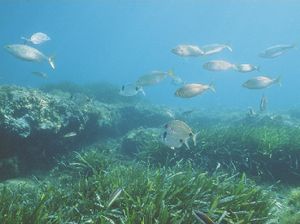Pollution and pelagic fish
Fish are continuously in contact with their environment through their gills . Therefore, unlike sea birds and marine mammals, they directly adsorb contaminants from their environment. Fish (both pelagic as benthic fish) can be contaminated by eating and by direct uptake from the water. As they form the top of the food chain, large carnivorous fish will also experience problems from biomagnifying substances like methylmercury and organochlorine compounds.[1]
Heavy metals
The presence of high concentrations of heavy metals forces the fishes to produce metallothioneins. The energy they have to spend on the production of these detoxifying proteins can no longer be used on growth or reproduction. Although adult marine fishes are thought to be rather protected from the effects of heavy metal concentration, the embryos and gametes remain quite vulnerable. [2]
Organochlorine compounds
Organochlorine pesticides have very often caused acute toxic effects in fish in the 1960s. As they were sprayed on agricultural areas near the coast, the pesticides tended to end up in large doses in nearby bays, resulting in massive local fish mortalities. This caused fisheries for instance in Laguna Madre, a bay in Texas, to collapse. [3] When present at lower concentrations, which don't cause acute toxicity, these organochlorines can also accumulate in the fishes. It is thought that these can lead to various sublethal effects. In the Elbe estuary in Germany chronic exposure might have resulted into reduced productive success, damage to the liver, kidneys and intestines in fishes.[2]
Given the variety of (sub-)lethal effects, which these pollutants (organochlorines and heavy metals) are known to have on fish, even rather low, non toxic concentrations can have a detrimental effect of fish stocks.[4]
Below you can find some links to Belgian case studies on ecotoxicology in pelagic fishes.
Case studies
Case study 1:Effects of xenoestrogens in eels[5]
References
- ↑ ↑ Kennish, M. J. (1996): Practical Handbook of Estuarine and Marine Pollution, CRC Press 524 pp
- ↑ 2.0 2.1 Fishes in Estuaries: M. Elliott, K.L. Hemingway (Eds.); Blackwell Science, Oxford, 636 pp
- ↑ Clark, R,B., 1999. Marine pollution. Oxford University press, Fourth edition, pp 161
- ↑ Sinderman, C.J. 2006. Coastal Pollution: Effects on Living Resources and Humans. CRC Press, Boca Raton, FL. 280 pp
- ↑ Versonnen, B.J.; Goemans, G.; Belpaire, C.; Janssen, C.R. (2004). Vitellogenin content in European eel (Anguilla anguilla) in Flanders, Belgium. Environ. Pollut. 128(3): 363-371
Please note that others may also have edited the contents of this article.
|
